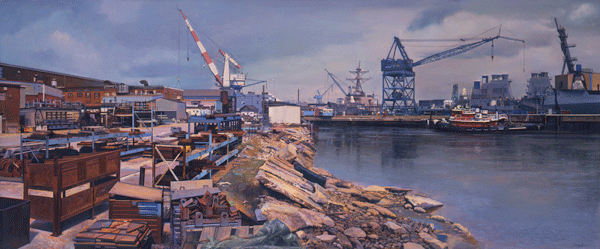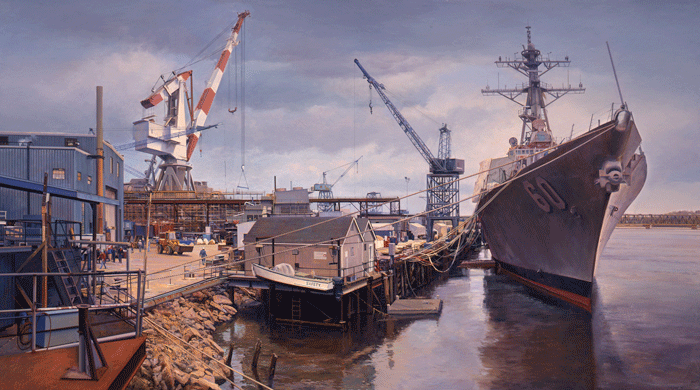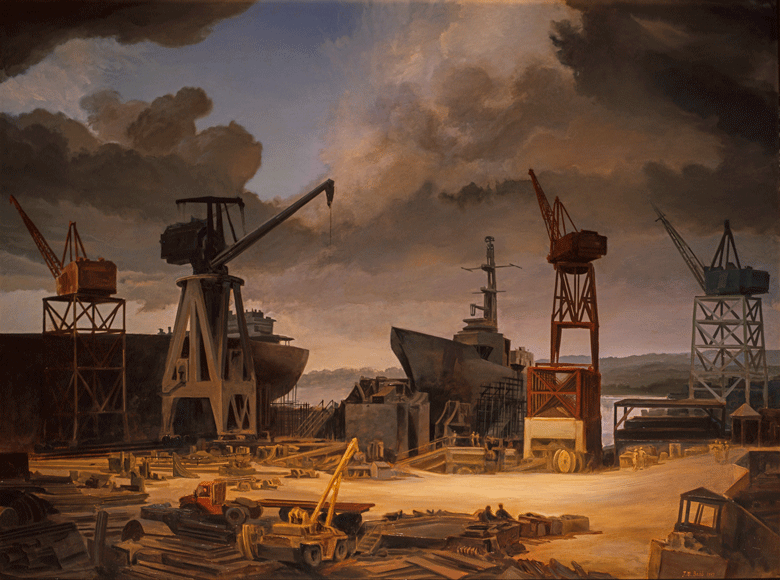
Bath Iron Works began building ships in the 1880s; one of its earliest vessels was an iron gunboat, the Machias, built for the U.S. Navy. Now owned by General Dynamics, one of the largest defense contractors in the world, the shipyard on the Kennebec River routinely receives accolades for its ship-building prowess and status as a major Maine employer while drawing the wrath of peace advocates who consider it a part of the country’s war machine.
Over its nearly 130-year existence, Bath Iron Works has also attracted artists. Carroll Thayer Berry (1886-1978) depicted the shipyard in full war-time mode in the early 1940s (some of his BIW canvases and prints can be found at the Farnsworth and Penobscot Marine museums). More recently, James Stilphin (1945-2006) made numerous drawings, paintings, and technical illustrations of the complex, many of them in the Maine Maritime Museum collection.
Joel Babb first painted BIW in 1977. At the time he was making plans to move here from Boston, where he was teaching at the Museum of Fine Arts, to his future home in Sumner. He had begun drawing outdoors in pen and ink and watercolor, then returning to his studio to paint.

The Iron Works, based on sketches made from the shipyard’s perimeter, presents the construction site under ominous skies, only a few figures visible here and there beneath towering cranes. With a stage set feel, the painting brings to mind views of Roman ruins by Piranesi.
In the early 1990s, Babb returned to the shipyard with a letter of introduction, as it were, from John Ames, owner of Gallery 68 in Belfast, to Duane “Buzz” Fitzgerald, BIW’s CEO. Fitzgerald (1939-2002) arranged for the painter to take photos in the yard.
“It was fascinating to learn about the logistics of fabrication in sections,” Babb recalls, “and… the amazing capacities of the ships to perform when finished.”
Babb ended up painting two canvases from photographs taken with a 4-by-5 camera. One of them, the wide-angle Water’s Edge, features an assortment of pieces of steel, “rusted to every possible shade of red orange,” the artist notes. The piles of abstract forms provoked an “industrial fascination.”
The second painting, Leviathans, The Bath Iron Works, is more dramatic, showing the mighty USS Paul Hamilton, an Arleigh Burke-class destroyer, tied to the dock. The view from under the foreshortened bow of the ship, writes Babb, “suggests the speed and power of the vessel.”
As in his acclaimed Boston cityscapes, Babb is meticulous in rendering the scene. Scanning the canvas, one takes in a multitude of details: the great gray hull, a small suspended “safety” boat, a yellow front-end loader, and all sorts of equipment, scaffolding and buildings. With its distinct orange and white pattern, the giant crane that is visible from Bath might be the squared twin of West Quoddy Head Light.
Today, Leviathans hangs in the Bath Iron Works Center for Advanced Technology at Maine Maritime Academy, a gift of Maine philanthropist Elizabeth Noyce (1930-1996). In her lifetime Noyce created a remarkable collection of Maine art, much of which she bequeathed to Maine museums and other institutions.
Babb would love to return to Bath Iron Works one day and do more paintings: “It’s a fabulous, inspiring subject,” he says. Until then we can admire his iconic image of one of Maine’s most renowned working waterfronts in its full ship-building glory.
Carl Little is the author of Nature & Culture: The Art of Joel Babb (University of New England Press).





